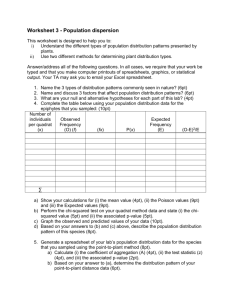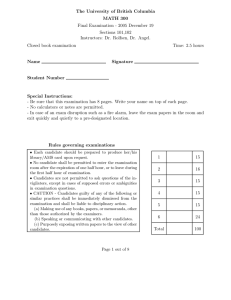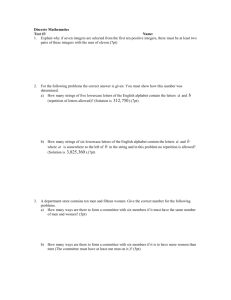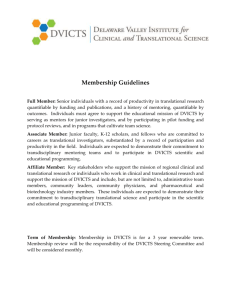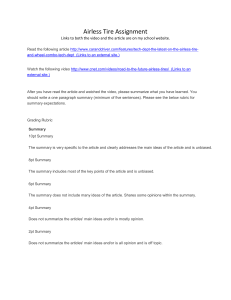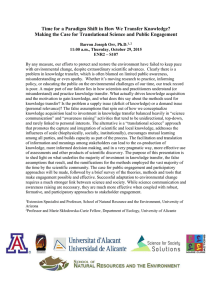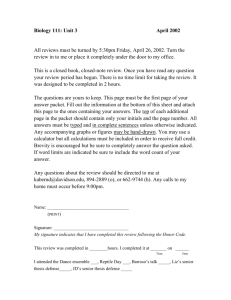Recent Developments on Direct Relative Orientation
advertisement
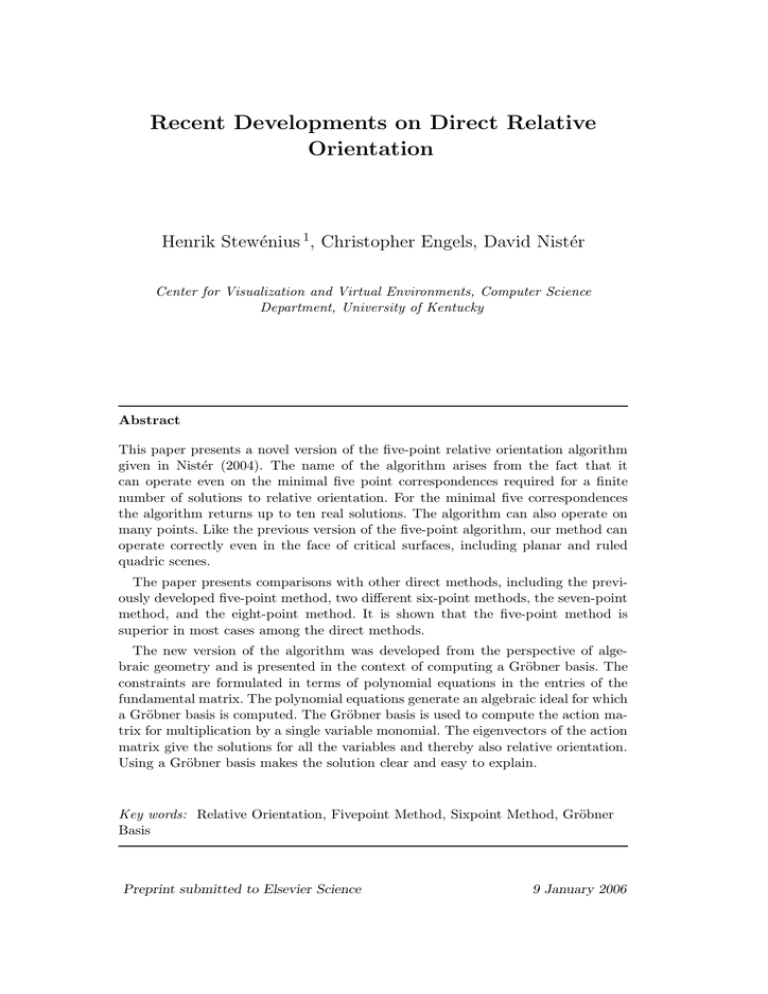
Recent Developments on Direct Relative
Orientation
Henrik Stewénius 1, Christopher Engels, David Nistér
Center for Visualization and Virtual Environments, Computer Science
Department, University of Kentucky
Abstract
This paper presents a novel version of the five-point relative orientation algorithm
given in Nistér (2004). The name of the algorithm arises from the fact that it
can operate even on the minimal five point correspondences required for a finite
number of solutions to relative orientation. For the minimal five correspondences
the algorithm returns up to ten real solutions. The algorithm can also operate on
many points. Like the previous version of the five-point algorithm, our method can
operate correctly even in the face of critical surfaces, including planar and ruled
quadric scenes.
The paper presents comparisons with other direct methods, including the previously developed five-point method, two different six-point methods, the seven-point
method, and the eight-point method. It is shown that the five-point method is
superior in most cases among the direct methods.
The new version of the algorithm was developed from the perspective of algebraic geometry and is presented in the context of computing a Gröbner basis. The
constraints are formulated in terms of polynomial equations in the entries of the
fundamental matrix. The polynomial equations generate an algebraic ideal for which
a Gröbner basis is computed. The Gröbner basis is used to compute the action matrix for multiplication by a single variable monomial. The eigenvectors of the action
matrix give the solutions for all the variables and thereby also relative orientation.
Using a Gröbner basis makes the solution clear and easy to explain.
Key words: Relative Orientation, Fivepoint Method, Sixpoint Method, Gröbner
Basis
Preprint submitted to Elsevier Science
9 January 2006
1
Introduction
Relative orientation has always been and remains one of the most important
operations in photogrammetry. A review of the history of relative orientation is given by Wrobel in Gruen and Huang (2001). The gold standard is to
perform bundle adjustment McGlone et al. (2004); Triggs et al. (2000); Wolf
(1983), which is widely used and has been intensively studied. Bundle adjustment is the way to achieve the best accuracy that the data affords and should
preferably always be used as the final computational stage of a relative orientation, unless an application has prohibitive constraints, such as real-time
requirements.
Bundle adjustment is typically started from an approximate configuration of
the scene points and camera poses. With a sufficiently accurate initial configuration, this will lead to satisfactory convergence of the bundle adjustment.
However, with an inaccurate initial configuration there is no guarantee that
the bundle adjustment will find the globally optimal solution.
Recently there have been several advances on direct relative orientation methods Philip (1996); Nistér (2004). By direct we intend any method with guaranteed convergence to a global optimum, which includes closed form solutions
and solutions using singular value decomposition or eigenvalue decomposition.
A review of the various direct methods is given by Förstner and Wrobel in
McGlone et al. (2004).
The direct methods, although not minimising the preferred image reprojection error, have the advantage of not getting stuck in a local minimum of the
cost function. They can be used to obtain an initial configuration to use in
bundle adjustment when no accurate initial configuration is available. They
have also proven very effective as hypothesis generators in hypothesise-andtest algorithms such as RANSAC used to perform automatic relative orientation directly from the raw images, including automatic feature extraction
and matching, see for example see for example Fischler and Bolles (1981);
McGlone et al. (2004); Nistér (2003).
In such hypothesise-and-test algorithms, many minimal sets of point correEmail addresses: stewe@vis.uky.edu (Henrik Stewénius),
engels@vis.uky.edu (Christopher Engels), dnister@vis.uky.edu (David
Nistér).
URLs: http://www.vis.uky.edu/~stewe/ (Henrik Stewénius),
http://www.vis.uky.edu/~engels/ (Christopher Engels),
http://www.vis.uky.edu/~dnister/ (David Nistér).
1 This work is partially funded by the project VISCOS (foundation for strategic
research), by EU project SMErobot and by the Swedish Research Council.
2
spondences are used to generate hypotheses for the relative orientation. Thus,
the direct relative orientation method is actually used on a very small number
of points each time, which is done to avoid the effects of outliers. The best relative orientation hypothesis generated in this manner is then found according
to a robust version of reprojection error using all the corresponding points.
The most well-known direct methods have been named based on the smallest
number of points that they require in order to operate correctly and yield a
finite number of possible solutions for the relative orientation. For the core
task of performing relative orientation of two views with calibrated intrinsic
parameters, which entails estimating the relative rotation and the translation
direction between the two views, the minimal number of point correspondences
required is five.
The five-point problem was first shown by Kruppa (1913) to have at most
eleven solutions (here, the twisted pair ambiguity is not considered a real
ambiguity since it can be resolved by requiring that the scene points are in
front of the cameras). This was improved upon more recently Faugeras and
Maybank (1990), showing that it has at most ten solutions. It has also been
found Nistér (2004) that there are pathological cases with ten real solutions
that are well separated in parameter space and have all the scene points in
front of the cameras.
Kruppa also gave an algebraic algorithm for solving the five-point problem,
although it is not very amenable to efficient practical implementation. Efficient
practical solutions to the five-point problem have been given more recently.
Philip (1996) gave a method that finds the solutions for relative orientation
by extracting the roots of a thirteenth-degree polynomial. This was improved
upon by Nistér (2004). The solutions are found as the roots of a tenth-degree
polynomial, which corresponds exactly to the intrinsic degree of difficulty of
the problem.
In this paper, we present a novel version of this algorithm. The new version is
solidly grounded in algebraic geometry and based on standard methods from
this field. We compare it to the previous version and show that the new version
is more numerically stable. The new version works by deriving a Gröbner basis
for the ideal generated by the polynomial constraints on the essential matrix.
This is done in a straightforward manner. The Gröbner basis can then be used
to construct a 10 × 10 matrix whose eigenvalues and eigenvectors encode the
solutions. The matrix is an action matrix for multiplication in the quotient
ring of polynomials modulo the ideal generated by the polynomial constraints.
This type of action matrix is a standard way of solving polynomials and we
review some of this theory. For a more complete treatment of the tools used,
see Cox et al. (1997, 1998).
3
Fig. 1. We give a novel version of the direct method to solve for relative orientation
of two cameras given five or more point correspondences.
The five-point method has the advantage that it works for planar scenes and
also quadric critical surfaces. That is, it yields a number of possible solutions as
usual, among which the true solution resides. The analysis of the algorithms
(excepting the six-point method of Pizarro) under critical configurations is
addressed in Philip (1998).
This is obviously useful if the scene is actually planar or a critical surface, but
it also gives the five-point method better stability for near-planar and nearcritical surfaces. There are direct methods that explicitly assume a planar
scene, see for example McGlone et al. (2004); Faugeras (1993). However, these
do not apply to near-planar scenes. The five-point method can operate both in
the general case and seamlessly into a completely planar scene. To the best of
our knowledge, there is only one other direct method apart from the five-point
method that could claim this desirable property. This is the six-point method
of Pizarro Pizarro et al. (2003), which selectively uses the constraints from
six point correspondences and yields up to six solutions. For general scenes,
six point correspondences can be used to solve linearly for relative orientation
as described by Philip (1996). However, this breaks down for a planar scene
Philip (1998).
In our experiments we compare the five-point method with the six-point methods of Pizarro and Philip. We also compare to the seven and eight-point methods and find that the five-point method is superior among all the direct methods for minimal cases. The seven and eight-point methods operate without
using any assumptions about the intrinsic parameters of the cameras, except
for assuming a pinhole camera model. Seven points then lead to up to three
solutions Sturm (1869); Hartley and Zisserman (2000) and eight points lead
to a linear solve for a unique solution von Sanden (1908); Longuet-Higgins
(1981).
All of these methods can also operate with many points and not only with
the minimal sets of points. This is done in a least squares fashion by finding
an approximate null-vector through the use of singular value decomposition.
However, the least squares measure minimised is not the preferred image repro4
jection error and it is not clear without experimentation that the algorithms
can make efficient use of the additional points. We present extensive experiments with large point sets and find that the five-point method provides the
most consistent results among the direct methods also at using many points.
The rest of the paper is organised as follows. First an introduction to the geometric constraints used will be given in Section 2 followed by an introduction
to the tools of algebraic geometry in Section 3. In Section 4 our new method is
explained and in Section 6 the new solver is compared both to the old version
of the five-point algorithm as well as other direct methods.
2
The algebraic constraints
The methods for relative orientation of two views all use the well known coplanarity McGlone et al. (2004), or epipolar constraint, which is encoded by the
3 × 3 fundamental matrix F as
q ′⊤ F q = 0,
(1)
where q and q ′ are the homogeneous coordinates of the two points from a
point correspondence. We will focus on how the various methods find the
fundamental matrix. To obtain the relative rotation and translation direction
from the fundamental matrix is a standard operation, see for example McGlone
et al. (2004). Any rank-two matrix is a possible fundamental matrix and we
have the well known single cubic constraint:
Theorem 1 A real non-zero 3 × 3 matrix F is a fundamental matrix only if
it satisfies the equation
det(F ) = 0.
(2)
If we have calibrated cameras and use the calibrated coordinate system, the
fundamental matrix specialises to an essential matrix E. An essential matrix
has the additional property that the two non-zero singular values are equal.
This constraint is straightforward to verify on a given matrix. To express it
algebraically, we need the following cubic constraints on the essential matrix,
adapted from Stefanovic (1973); Demazure (1988); Maybank (1993); Philip
(1996):
Theorem 2 A real non-zero 3 × 3 matrix E is an essential matrix if and only
if it satisfies the equation
2EE ⊤ E − trace(EE ⊤ )E = 0.
5
(3)
The constraints from Equations (1), (2) and (3) are are used in order to
compute the essential matrix, it is possible to use a lower number of equations
but this makes the problem harder and more unstable. For more on these
constraints, see Philip (1996).
3
Algebraic geometry
Algebraic geometry deals among other things with solving sets of multivariate
polynomial equations such as the ones from Section 2. Our novel version of
the five-point solver relies on results from this field, and we will briefly review
the relevant material. For a more complete treatment of the tools used, see
Cox et al. (1997, 1998).
A monomial in the unknowns (x1 , . . . , xn ) is a finite product of these unknowns
and a polynomial is a finite sum of monomials. When computing and writing
out polynomials the order of the monomials is very important and we will here
first order them according to degree, highest degree first, and then within each
degree according to phone-book (lexicographic) order. Ordering the monomials
like this is usually more efficient than using a pure lexicographic order. The
leading term of a polynomial is the first non-zero term.
For a set of polynomials {pi }, the ideal I({pi }) is defined as the set of polynomials
nX
o
βi pi | βi ∈ C[x1 , . . . , xn ] .
(4)
All polynomials in the ideal I({pi }) evaluate to zero on the set of solutions to
{pi }. The leading terms of an ideal is the set of leading terms of all members
of the ideal.
A Gröbner basis G of the ideal I({pi }) is a set of polynomials in I({pi }) such
that every leading term of I({pi}) is divisible by the leading term of some
member of G.
Since a Gröbner basis of an ideal I exposes all the leading terms of I, it gives
a way of uniquely defining the remainders modulo I. We can thus consider the
quotient ring C[x1 , . . . , xn ]/I, which is the set of distinct remainders modulo
I. Intuitively, the quotient ring is the set of equivalence classes of polynomials
that appear distinct when evaluated at the solutions to {pi }. The dimensionality of the quotient ring is equal to the number of solutions. If the number of
solutions is finite, then the dimensionality of the quotient ring is finite.
The monomials that are indivisible by the leading terms of G form a basis for
6
C[x1 , . . . , xn ]/I. If we label the basis monomials u1 (x), . . . , uN (x) and gather
them in a vector
u(x) = u1 (x) . . . uN (x)
⊤
,
(5)
we can use an N-dimensional coefficient vector v to represent any element
u(x)⊤ v in the quotient ring. Multiplication by a fixed polynomial f in the
quotient ring is then a linear operator and the N × N matrix describing the
operation is called the action matrix Af . The action matrix works on the
coefficient vectors in such a way that
f (x)u(x)⊤ v = u(x)⊤ Af v,
∀v ∀x ∈ V,
(6)
∀x ∈ V.
(7)
which implies that
f (x)u(x)⊤ = u(x)⊤ Af ,
Note that this is the same as saying that if x is a solution to our polynomial
equations, then u(x) is a left eigenvector to the action matrix Af , corresponding to the eigenvalue f (x). This means that for a general polynomial f , the
N left eigenvectors of the action matrix Af are up-to-scale versions of the
monomial vector u(x) at the N solutions x ∈ V .
Given a Gröbner basis for I, it is straightforward to compute the action
matrix corresponding to any polynomial. With GrLex order, the monomials
x1 , . . . , xn , consisting of the variables themselves, are typically present in the
monomial basis. Hence, we can simply choose some simple polynomial f , for
example f = x1 , compute the action matrix Af , and then read off the values
of the variables at all the solutions directly from the left eigenvectors of Af .
All we need is the Gröbner basis. We will find in Section 4 that in the case of
the five-point problem this can be computed in a straightforward manner.
4
Solving the problem
Below we will give a detailed description of the five-point algorithm. However,
the steps can be summarised for the reader familiar with algebraic geometry
as
(1) Use the linear equations from the epipolar constraint (1) to parametrise
the essential matrix with three unknowns.
(2) Use the rank constraint (2) and the trace constraint (3) to build ten
third-order polynomial equations in the three unknowns. The monomials
7
are ordered in GrLex order and represented in a 10 × 20 matrix, where
each row corresponds to an equation and each column corresponds to a
monomial.
(3) Compute the Gröbner basis. This turns out to be as simple as performing
a Gauss-Jordan elimination on the 10 × 20 matrix.
(4) Compute the 10 × 10 action matrix for multiplication by one of the unknowns. This is a simple matter of extracting the correct elements from
the eliminated 10 × 20 matrix and organising them to form the action
matrix.
(5) Compute the left eigenvectors of the action matrix. Read off the values
for the three unknowns at all the solution points and back-substitute to
obtain the solutions for the essential matrix.
We now proceed to present the details. As the observations (qi , qi′ ) are known,
the epipolar constraint (1) gives five linear constraints on the essential matrix
E. An orthogonal basis for the four-dimensional null-space of these constraints
is then computed using singular value decomposition. In the case of more than
five points, we generate the equations for all the points in the same way and
compute the closest approximation to a four-dimensional null-space by using
the four singular vectors corresponding to the four smallest singular values.
It is now possible to rewrite E as
E = xE1 + yE2 + zE3 + wE4 ,
(8)
where Ei are the components of the null-space for the epipolar constraint. It
is only possible to solve for E up to scale, so we set w = 1 and there are then
three (x, y, z) remaining unknowns. Inserting E into constraint (2) and (3)
gives ten polynomial equations of degree three. There are twenty monomials
up to degree three in the unknowns (x, y, z) and we choose to work in GrLex
(x > y > z). This gives the following monomials vector:
⊤
X= x , x y, x z, xy , xyz, xz , y , y z, yz , z , x , xy, xz, y , yz, z , x, y, z, 1
3
2
2
2
2
3
2
2
3
2
2
2
,
(9)
note that the first 10 monomials are cubic and the other are of degree two or
lower. The ten equations can now be written
MX = 0,
(10)
where M is a 10 × 20 matrix. The rows of the matrix turn out to be linearly
independent in general. After Gauss-Jordan elimination the system can be
written
8
I B X = 0,
(11)
where I is the 10 × 10 identity matrix and B a 10 × 10 matrix. Knowing
that there are ten solutions, it is easy to see that this set of equations must
be a GrLex Gröbner-basis (since there are only ten monomials that are not
divisible by any of the leading monomials from the equations).
The action matrix Ax for multiplication by x is then computed by considering
the action of x on the basis monomials of C[x, y, z]/I. The ten sets of solutions
can then be read of out from the the eigenvectors of Atx after normalizing the
last element to 1. The above can appear a bit complicated but given the matrix
M the above steps are performed by the following piece of Matlab code:
B = M(:,1:10)\M(:,11:20);
At = zeros(10);
At = -B([1 2 3 5 6 8], :);
At(7,1) = 1;
At(8,2) = 1;
At(9,4) = 1;
At(10,7) = 1;
[V,D] = eig(At);
SOLS =
V(7:9,:)./(ones(3,1)*V(10,:));
A weakness in this scheme is that it is assumed that w 6= 0. For better stability
it is possible to compute the solutions as normalized to 1 but then the number
of solutions is doubled.
5
The other methods
In Section 6, the five-point method will be compared to some other direct
methods. Common to all these methods is that they first use the N observed points in the epipolar constraint (1) to get linear constraints on the
Fundamental/Essential matrix. The possible fundamental matrices are then
parametrised as
F = x0 F0 +
8−N
X
xi Fi ,
(12)
i=1
where Fi are basis vectors for the null-space of the constraints. As F can only
be determined up to scale, x0 is set to zero. For N < 8 the remaining uncertainty is removed by inserting F into constraint (2), and when the intrinsic
calibration is known, constraint (3). The resulting equations are used to com9
pute a polynomial in x1 and solutions to the other variables are computed
through back-substitution. The fundamental matrix is then computed from
Equation (12).
The methods we compare are:
• The old version of the five-point method Nistér (2004). From the 10 equations in (2) and (3) a tenth degree polynomial in x1 is computed. The roots
of the polynomial are computed by eigen-decomposing a companion matrix.
This method is more reliable than the faster option from Nistér (2004) of
using Sturm sequences to bracket the roots.
• The six-point method of Pizarro et al. (2003). The 9 equations from (3) are
composed into a 9 × 10 matrix from which the 4 rows corresponding to the
four largest singular values are selected. From these four equations, a sixth
degree polynomial in x1 is computed.
• The linear six-point solver from Philip (1998). The 9 equations in (3) are
composed into a 9 × 10 matrix and the unknowns are solved for linearly.
• The seven-point solver. The rank constraint (2) gives a third degree polynomial in x1 .
• The eight-point algorithm. A linear solver.
6
Experiments
We first compare the numerical error between the novel and previous five-point
methods. We then compare the other methods to the new five-point method
under various noisy conditions. Finally, we present a short real-world example.
6.1 Numerical precision
In order to investigate the precision of the five-point algorithms, we examine
the numerical error on synthetic data in noise-free yet geometrically realistic
conditions. For the purposes of numerical testing, we use the minimal set of
five points. Note that more points only affect the computation of the initial
null space, performed by singular value decomposition, which is known to be
numerically stable. Since the algorithms produce multiple up-to-scale solutions
for the essential matrix, we compute the error measure
min min(k
i
Êi
E
E
Êi
−
k, k
+
k),
k E k k Êi k
k Êi k k E k
(13)
where Êi are the ten estimated essential matrices, and E is the true essential
matrix. In each case, we sample 50000 minimal sets of points and record the
10
resulting numerical errors. Note that we use double precision computations,
so the maximum numerical precision of the machine is 2.2204e − 16.
We construct the configurations of cameras and points using the following
parameters: number of points, scene depth, scene distance, scene width, baseline, and motion direction. We set the first camera at the origin and randomise
scene points uniformly inside a block straight in front of it. The block starts
at the scene distance, and the thickness of the block is the scene depth. The
second camera is positioned according to the motion direction and baseline
and is oriented toward the centroid of the scene points. As the default conditions for all the tests, the distance to the scene from the camera is 2, as is the
width of the scene, which translates to a field of view of about 53 degrees. The
default magnitude of the baseline to the second camera is 0.2. For non-planar
scenes, the default scene depth is 2. We would expect a wider baseline to yield
more accurate results, which we verify in Section 6.2
Figure 2 shows results for sideways camera motion of a non-planar scene. The
results for a planar scene are shown in Figure 3, and the results for forward
motion in a non-planar scene are in Figure 4. The results indicate only a
minor increase in accuracy; note however that the histogram of the errors in
the previous method has a tail consisting of a small number of substantial
errors, whereas the new method eliminates the larger errors, and the largest
error in that set is less than 10−5 . These errors result in a mean error for the
previous method of approximately 10−5 , while the mean error of the revised
method was less than 10−10 .
3000
3000
2000
2000
1000
1000
0
−15
log
−10
−5
of Numerical Error
0
−15
0
log
−10
−5
of Numerical Error
0
10
10
Fig. 2. Distribution of the numerical error of the five-point methods for sideways
motion under normal conditions, 50000 samples. Left: Previous method. Right: New
method. The median numerical error of the previous method is 1.9466e-14, while
the median error for the new method is 1.6351e-14.
2500
2500
2000
2000
1500
1500
1000
1000
500
500
0
−15
−10
−5
log10 of Numerical Error
0
0
−15
−10
−5
log10 of Numerical Error
0
Fig. 3. Distribution of the numerical error of the five-point methods for sideways
motion under planar conditions, 50000 samples. Left: Previous method. Right: New
method.
11
1000
1000
500
500
0
−15
−10
−5
log10 of Numerical Error
0
0
−15
−10
−5
log10 of Numerical Error
0
Fig. 4. Distribution of the numerical error of the five-point methods for forward
motion under normal conditions, 50000 samples. Left: Previous method. Right: New
method.
6.2 Performance under noise
In this section we compare the results of the new five-point method and other
methods under noisy conditions. The default parameters are the same as those
used in the numerical tests, except that we also simulate feature location errors
by introducing a noise parameter into the image data. In the default case, we
include a Gaussian perturbation in each image point with a standard deviation
of one pixel in a 2000×2000 pixel image. To compare the methods, we measure
the angle of translational error between the estimated solutions and the true
motions in various situations. Each data point represents the median value of
5000 samples.
In the following experiments we consider both solutions from the minimal
sets of points necessary for each method, i.e. 5,6,7, or 8 points, as well as
nonminimal sets of 50 points. Figure 5 shows the results of increasing the
number of points used in each algorithm beyond the minimal cases for both
sideways and forward motion. Note that the five-point, six-point, and eightpoint methods benefit the most from additional points, although the sevenpoint method also benefits somewhat. The seven-point, eight-point, and sixpoint linear methods also have a bias towards forward motion Nistér (2004),
which partially accounts for the improvement of those methods in the forward
case. The linear six-point solver does not perform well using additional points,
so we preclude it from further non-minimal case tests.
10
5pt
6pt
7pt
8pt
6pt linear
30
translational error (deg)
translational error (deg)
40
20
10
0
1
10
2
10
number of points
6
4
2
0
3
10
5pt
6pt
7pt
8pt
6pt linear
8
1
10
2
10
number of points
3
10
Fig. 5. Translational error relative to number of points. Left: sideways motion. Right:
forward motion
12
We also measure the failure rate of the various algorithms. We define the failure
rate at a specific error threshold to be the percentage of instances solved that
give no solutions where the translational error is less than the specified error.
The distributions of the error levels are shown in Figure 6 and the failure
rates are shown in Figure 7. Note that in the minimal case, which is useful
for creating hypotheses for RANSAC Fischler and Bolles (1981), the five-point
method is clearly the best choice. In the overdetermined case, the performances
of the five-point, six-point, and eight-point methods are comparable, while the
seven-point also improves somewhat.
Figure 8 shows the stability of the algorithms under increasing noise. In
each case, we create Gaussian error that simulates up to a one pixel error in a
2000 × 2000 image. Note that the five-point method is generally least affected
5pt, 50pts
5pt, Minimal Case
500
2000
400
300
2500
250
2000
200
300
1500
150
1000
200
1000
100
100
0
0
6pt, 50pts
6pt, Minimal Case
3000
600
500
50
20
40
60
80
0
0
translational error (deg)
7pt, Minimal Case
0
0
20
40
60
80
translational error (deg)
7pt, 50pts
400
140
20
40
60
80
0
0
translational error (deg)
8pt, Minimal Case
20
40
60
80
translational error (deg)
8pt, 50pts
2000
150
120
300
100
1500
100
80
200
60
1000
50
40
100
500
20
0
0
20
40
60
80
translational error (deg)
0
0
0
0
20
40
60
80
translational error (deg)
6pt Linear, Minimal Case
20
40
60
80
translational error (deg)
6pt Linear, 50pts
0
0
20
40
60
80
translational error (deg)
200
120
100
150
80
100
60
40
50
20
0
0
20
40
60
translational error (deg)
0
0
80
20
40
60
80
translational error (deg)
Fig. 6. Distribution of translational error over 10000 samples of the methods using
minimal cases (left) and 50 points (right) for sideways motion. From top to bottom:
five-point, six-point, seven-point, eight point, and linear six-point methods.
failure rate
0.75
1
5pt
6pt
7pt
8pt
6pt linear
0.75
failure rate
1
0.5
0.25
0
0
5pt
6pt
7pt
8pt
6pt linear
0.5
0.25
0
0
20
40
60
80
error threshold (deg)
20
40
60
80
error threshold (deg)
Fig. 7. Failure rate relative to a required error threshold for sideways motion. Left:
minimal cases. Right: 50 points.
13
20
10
0
0
0.2
0.4
0.6
0.8
8
6
4
2
0
0
1
12
5pt
6pt
7pt
8pt
6pt linear
0.2
noise (pixels)
0.4
0.6
0.8
10
8
5
translational error (deg)
30
10
5pt
6pt
7pt
8pt
6pt linear
translational error (deg)
40
translational error (deg)
translational error (deg)
50
5pt
6pt
7pt
8pt
6
4
2
0
0
1
0.2
noise (pixels)
0.4
0.6
0.8
4
3
2
1
0
0
1
5pt
6pt
7pt
8pt
0.2
noise (pixels)
0.4
0.6
0.8
1
noise (pixels)
30
5pt
6pt
7pt
8pt
6pt linear
60
40
20
0
0
0.1
0.2
0.3
0.4
0.5
100
5pt
6pt
7pt
8pt
6pt linear
25
20
translational error (deg)
translational error (deg)
translational error (deg)
80
15
10
5
0
scene depth to distance ratio
0.1
0.2
0.3
0.4
5pt
6pt
7pt
8pt
80
60
40
20
0
0
0.5
translational error (deg)
Fig. 8. Translational error relative to Gaussian noise equivalent to one pixel in a
2000×2000 pixel image. From left to right: sideways motion, minimal cases; forward
motion, minimal cases; sideways motion, 50 points; forward motion, 50 points
scene depth to distance ratio
0.1
0.2
0.3
0.4
0.5
14
5pt
6pt
7pt
8pt
12
10
8
6
4
2
0
0
0.1
0.2
0.3
0.4
0.5
scene depth to distance ratio
scene depth to distance ratio
Fig. 9. Translational error relative to scene depth. From left to right: sideways
motion, minimal cases; forward motion, minimal cases; sideways motion, 50 points;
forward motion, 50 points. Note the instability of the six-point algorithm in the
sideways motion 50 point case.
20
0
0
0.5
1
1.5
Baseline to depth ratio
15
10
5
0
0
0.5
1
60
40
20
0
0
1.5
Baseline to depth ratio
20
5pt
6pt
7pt
8pt
80
0.5
1
Baseline to depth ratio
1.5
translational error (deg)
40
100
5pt
6pt
7pt
8pt
6pt linear
20
translational error (deg)
60
25
5pt
6pt
7pt
8pt
6pt linear
translational error (deg)
translational error (deg)
80
5pt
6pt
7pt
8pt
15
10
5
0
0
0.5
1
1.5
Baseline to depth ratio
Fig. 10. Translational error relative to increasing baseline. From left to right: sideways motion, minimal cases; forward motion, minimal cases; sideways motion, 50
points; forward motion, 50 points
by the noise, although the seven-point and eight-point methods have a forward
bias that becomes particularly apparent in the forward nonminimal case. As
seen in Figure 9, the five-point and six-point algorithms maintain stability
while the seven-point and eight-point algorithms fail in the degenerate case
of a planar scene. Note that in the sideways nonminimal case, the six-point
method seems to lack stability in the near-planar range, even though it works
as expected for the true planar case. Figure 10 shows the results of increasing
the baseline between the cameras in both sideways and forward motion. Once
again, the five-point generally produces the least translational error, except in
the forward nonminimal case. From Figure 10, we can see that the differences
between the procedures become smaller for more favorable base to depth ratios
which are common in photogrammetry. Note again that the average base to
depth ratio used in the other experiments is about 0.1 to 1, while in many
photogrammetric applications one tries to reach a ratio of 0.5 to 1.
14
Fig. 11. Computed camera motion using a turntable sequence using the five-point
method. No constraints were placed on the system enforcing the circular structure.
6.3 Real Example
Figure 11 shows an example of the capabilities of the five-point method. Here,
we use the method within a RANSAC framework, followed by local bundle
adjustment.
7
Conclusions
In the experimental section of this paper we have shown that the novel fivepoint method gives more consistent results than the other direct methods in all
tested situations. The only other method that can handle both planar and nonplanar cases is the six-point method. However, we found in the experimental
section that the practical performance of the six-point method is not seamless
into the planar case. We have also shown that the new method is numerically
more stable than the previous five-point method.
Finally, we have shown the advantages of using the framework of algebraic geometry in order to get a systematic and straight-forward and easily explained
solution to the five-point problem. The existing solver to the fivepoints problem was quite difficult to implement and in order to remove this barrier from
trying the fivepoints algorithm we also provide a matlab version Stewénius
(2005b).
References
Cox, D., Little, J., O’Shea, D., 1997. Ideals, Varieties, and Algorithms.
Springer-Verlag New York.
Cox, D., Little, J., O’Shea, D., 1998. Using Algebraic Geometry, SpringerVerlag New York.
Demazure, M., 1988. Sur Deux Problemes de Reconstruction, Technical Report No 882, INRIA, Rocquencourt, France.
15
Faugeras, O., Maybank S., 1990. Motion from Point Matches: Multiplicity of
Solutions, International Journal of Computer Vision, 4(3):225-246.
Faugeras, O., 1993. Three-Dimensional Computer Vision: a Geometric Viewpoint, MIT Press, ISBN 0-262-06158-9.
Fischler, M., Bolles, R., 1981. Random Sample Consensus: a Paradigm for
Model Fitting with Application to Image Analysis and Automated Cartography, Commun. Assoc. Comp. Mach. 24:381-395.
Gruen, A., Huang, T. S., 2001. Calibration and Orientation of Cameras in
Computer Vision, Springer-Verlag, ISBN 3-540-65283-3.
Hartley R., Zisserman, A., 2000. Multiple View Geometry in Computer Vision,
Cambridge University Press, ISBN 0-521-62304-9.
Kruppa, E., 1913. Zur Ermittlung eines Objektes aus zwei Perspektiven mit
Innerer Orientierung, Sitz.-Ber. Akad. Wiss., Wien, Math. Naturw. Kl., Abt.
IIa., 122:1939-1948.
Longuet-Higgins, H., 1981. A Computer Algorithm for Reconstructing a Scene
from Two Projections, Nature, 293(10):133-135.
Maybank, S., 1993. Theory of Reconstruction from Image Motion, SpringerVerlag, ISBN 3-540-55537-4.
Nistér, D., 2003. Preemptive RANSAC for Live Structure and Motion Estimation, Proc. IEEE International Conference on Computer Vision, pp.
199-206.
Nistér, D., 2004. An Efficient Solution to the Five-Point Relative Pose Problem, IEEE Transactions on Pattern Analysis and Machine Intelligence,
26(6):756-770.
Philip, J., 1996. A Non-Iterative Algorithm for Determining all Essential
Matrices Corresponding to Five Point Pairs, Photogrammetric Record,
15(88):589-599.
Philip, J., 1998. Critical Point Configurations of the 5-, 6-, 7-, and 8-point
Algorithms for Relative Orientation, TRITA-MAT-1998-MA-13.
Pizarro, O., Eustice, R., Singh, H., 2003. Relative Pose Estimation for Instrumented, Calibrated Platforms, VIIth Digital Image Computing: Techniques
and Applications, Sydney.
McGlone, J.C., Mikhail, E.M., Bethel, J., Mullen, R. (Eds.), 2004. Manual of
Photogrammetry, fifth ed. American Society of Photogrammetry and Remote Sensing ISBN 1-57083-071-1.
Stefanovic, P., 1973. Relative Orientation - a New Approach, I. T. C. Journal,
1973-3:417-448.
Stewénius, H., 2005. Gröbner Basis Methods for Minimal Problems in Computer Vision, Ph.D. Thesis, Lund, Sweden.
Stewénius, H. Matlab code for the for solving the fivepoint problem.
http://www.maths.lth.se/~stewe/FIVEPOINT/.
Sturm, R. 1869. Das Problem der Projektivität und seine Anwendung auf die
Flächen zweiten Grades, Math. Annalen 1, 533-573.
Triggs, B., McLauchlan, P., Hartley, R., Fitzgibbon, A., 2000. Bundle Adjustment - a Modern Synthesis, Springer Lecture Notes on Computer Science,
16
Springer Verlag, 1883:298-375.
von Sanden, H., 1908. Die Bestimmung der Kernpunkte in der Photogrammetrie. Doct. Thesis, Univ. Göttingen.
Wolf, P. R, 1983. Elements of Photogrammetry. McGraw-Hill, New York.
17
